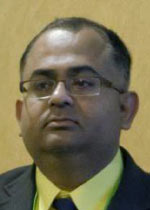Date
Cost
Free and open to the public
Location
Harris Corporation Engineering Center, Room 101A
Description
Experimental evidence indicates that the most important cause for cell death, mutation and transformations induced by ionizing radiations is damage to DNA [1]. The cell nucleus has a very different environment from a dilute aqueous solution owing to the high global concentration of macromolecules (DNA, RNA, proteins etc.) ranging from 65 to 220 mg/ml [2]. Due to the high radical scavenging capacity of the cell nucleus, free radicals produced via radiolysis of surrounding water, •OH, H-atom, solvated electrons (eaq¯) (i.e., indirect effect) are largely scavenged by proteins, glutathione and biomolecules other than DNA [1, 3]. The indirect effect occurs principally via hydroxyl radical (•OH) reactions since •OH is far more damaging than either the H-atom or solvated electrons [1]. Direct effect of ionizing radiation on DNA (DNA molecule plus the layer of solvation) thus accounts for up to 50% of the damage to DNA and it results in various diamagnetic products and strand breaks [1, 3].

Recent advances in our understanding of various mechanisms of both direct-type and indirect effects will be the major focus of this talk. We note here that major advances of the radical chemistry to elucidate mechanisms involved in direct and indirect effects have resulted from various radiation techniques including pulse radiolysis, ESR, mimetic approaches based on generating radicals site-specifically in DNA for example, via Norrish-type photoexcitations [4] aided with quantum chemical calculations [5]. Supported by the NIH NCI via grant R01 CA045424.
Reference
- Von Sonntag, C. Free-radical-induced DNA Damage and Its Repair; Springer-Verlag, Berlin, Heidelberg; 2006.
- The Nucleus. Volume 1: Nuclei and Subnuclear components, Methods in Molecular Biology 463; Hancock, R. Ed.; Humana Press, New Jersey, 2008.
- Becker, D.; Adhikary, A.; Sevilla, M. D. Physicochemical mechanisms of radiation induced DNA damage. In Charged Particle and Photon Interactions with Matter - Recent Advances, Applications, and Interfaces; Hatano, Y., Katsumura, Y., Mozumder, A. (Eds.), CRC Press, Taylor & Francis Group, Boca Raton, London, New York, 2010, 503–541.
- Greenberg, M. M. Org. Biomol. Chem., 2007, 5, 18 – 30.
- (a) Adhikary, A., Kumar, A., Becker, D., and Sevilla, M. D. Theory and ESR spectral studies of DNA-radicals. In Encyclopedia of Radicals in Chemistry, Biology, and Materials; C. Chatgilialoglu, A. Struder (Eds.), John Wiley & Sons, Ltd., Chichester, UK, 2012, 1371 – 1396.
(b) Adhikary, A., Becker, D., and Sevilla, M. D. (2014) Electron spin resonance of radicals in irradiated DNA. In Applications of EPR in radiation research (A. Lund, M. Shiotani (Eds.)), Springer-Verlag, Berlin, Heidelberg, (In Press).
Presenter

Amitava Adhikary, Ph.D.
Department of Chemistry
Oakland University
Rochester, Michigan
More information
Light refreshments will be served
Contact
Ushaben Lal NanoScience Technology Center 407-882-0032 usha@ucf.edu